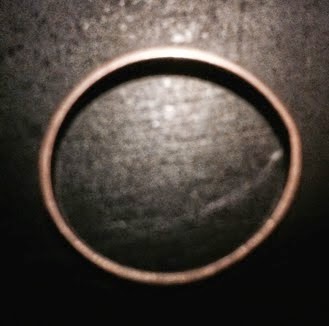The Wedding Ring
When my mother passed away a few years back I inherited her jewel case. She never had a lot of Jewels but she did leave her engagement ring, she also had an eternity ring and Nana's engagement ring. I was to have first choice of these then my sister Maureen had the next choice and my sister Erin was to inherit the last ring.
I did not know which I wanted to keep, Mum's engagement ring or Nana's. I asked Maureen to make the choice but she could not decide either. That was until she contacted me and asked if I had decided.
No.
She had a dream the night before and was having a conversation with Nana who asked where her ring was. Maureen told her I had it, and Nana said well you get it off her. This took my choice away, who was going to argue with Nana!
I have no idea of the value of these rings but both were pretty rings and both had sentimental value. However there was the jewel case and in this was a small plain gold ring. I thought at first this may have been Mum's original wedding ring as the one she wore was not the original one. I do not know where that went but I remembered her wedding ring and this one was not it either.
I then remembered Mum saying that she had her grandmother's wedding ring but I still did not know if this was it. On closer examination I noticed the ring had some kind of marking inside. It was so small it was impossible for me to see it so I took it to a Jeweller who told me it was an old ring, probably made in England and was 15ct rose gold.
This information did not help as Mum's grandparents, Patrick William John Murphy and Mary Ellen Josephine Woodhead were married in Melbourne.
Then I found a site on the internet that gave the opportunity to put up a photo of antique jewellery and find information about it. I had a macro lens for my iPhone so took a photo of the markings inside the ring and posted to http://www.antique-jewelry-investor.com
within no time at all I had the information I was looking for:-
I think it's more likely that your antique wedding ring was manufactured in Victoria, Australia in the late 19th early 20th century.
The "pretzel mark" that you mention, that we can see in first in the series of three impressions is the member jeweller of the Manufacturing Jeweller's Association of Victoria
J. LAWRENCE, Pty., Ltd ELIZABETH HOUSE
Then a few days later
yes, you are lucky indeed to have the ring marked,
because apart from documented pieces, and those still accompanied by their original receipt, most items of Australian Jewelry are unmarked as to their maker and often show only the quality mark of their silver or gold content. Other markings provided are the exception rather than the rule.
Insufficient attention has been given to these various marks found on some pieces of Australian Jewelry. These marks can include hallmarks like that are found on British gold and silver, pseudo- British hallmarks, initials, a single surname with and without initials,
business name and a variety of symbols including registration numbers and trade marks. TheTrademark is the practice of marking an item made from ANY material with signature or logo of the maker, jewelry manufacturer or sponsor. So the "knot" in the first impression could be described as the trademark or more befitting in early Australian jewelry terminology - Member's stamp.
The hallmark in Ellen's wedding ring is 15 and this was one of the country (Australia's) sanctioned guarantee of quality. This standard 15 was a relatively new standard mark in the late 19th century, and fits in with the British hallmarking system because in 1854 three lower standards were introduced in England, twelve, nine and fifteen carats.
The animal in the third impression is a sheep and 15 carat gold quality symbol for 15 carat gold (for Victoria) - In NSW the 15 carat, 9 carat and 18 carat quality symbol was a kookaburra.
This is what I needed!
It all fitted my great grandparents were married in St John's Church, Clifton Hills on 24 February 1897. By Father Richard Collins. Their witnesses were Patrick's brother James and Ada, possibly a friend of Mary Ellen's.
My plan is now to frame the photo above, or a copy of it, and pop the ring in to the frame with the photo to sit where I believe it now belongs.



That's an unusual line of research, a very interesting one, and as it turns out, very fruitful! Good on you.
ReplyDeleteAs an added note here, I have since found out that her wedding ring had 3 stones in it and my cousin has that ring. I still believe this ring belongs to Mary Ellen going on the size, she had very small fingers, where the Jeweller was and the time frame.
ReplyDeleteI am absolutely thrilled for you in what you achieved with that piece of research. An example to all of us..I just wish I had some jewellery which was old enough to take along your path of research.
ReplyDelete